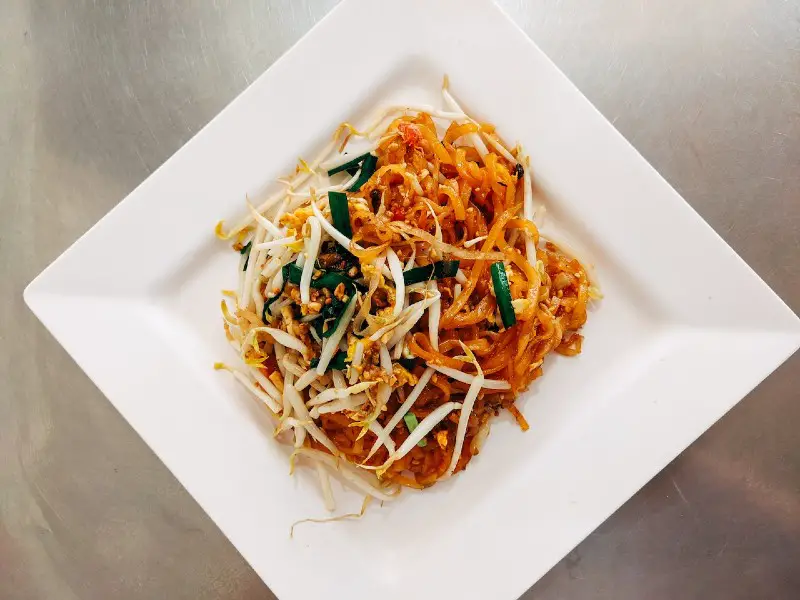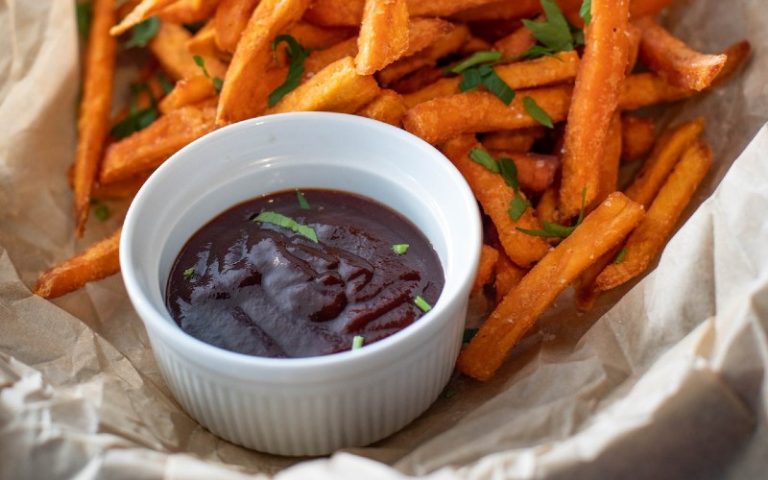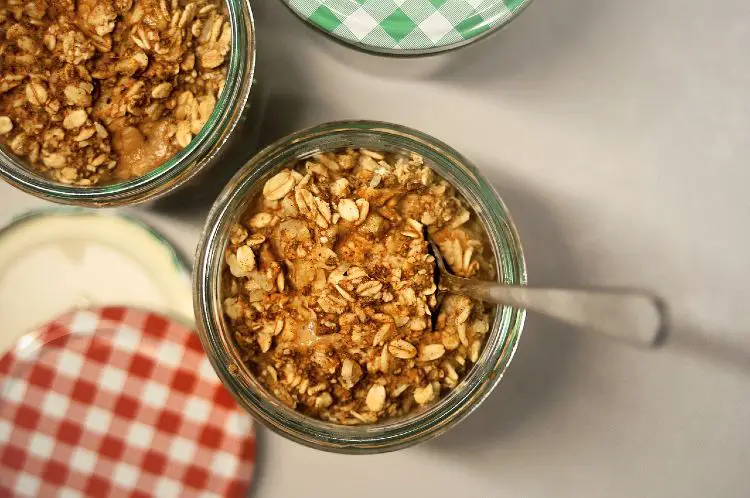What Does Pad Thai Taste Like?
Quick Answer
Pad Thai is a flavorful dish that offers a complex blend of sweet, salty, sour, and spicy notes. The use of ingredients like tamarind, fish sauce, sugar, and chilies creates a harmonious taste profile. The dish is often garnished with peanuts for a nutty flavor and lime wedges for a zesty finish. The textures range from the softness of the stir-fried noodles to the crunch of peanuts, making it a satisfying and multifaceted meal.
What is Pad Thai?
Pad Thai is a popular stir-fried noodle dish that hails from Thailand. It combines rice noodles with various proteins like chicken, shrimp, or tofu, and is tossed in a unique sauce made from tamarind paste, fish sauce, and sugar.
The dish is often garnished with ingredients like crushed peanuts, fresh cilantro, and lime wedges. Pad Thai has a complex flavor profile that balances sweet, salty, sour, and often spicy elements.
Basic Ingredients
- Rice Noodles
- Proteins
- Tamarind
- Fish Sauce
- Sugar
- Garnishes
What Does Pad Thai Taste Like?
Flavor Profile of Pad Thai
Sweetness
One of the fundamental flavors that define Pad Thai is its sweetness, usually derived from palm sugar or granulated sugar. While the dish itself is not overwhelmingly sweet, the sugar serves as a critical balancing agent, harmonizing the various flavors that make up this iconic meal.
How Sweetness Balances Other Flavors
The role of sweetness in Pad Thai is akin to a mediator in a conversation filled with strong opinions. It softens the tangy punch from the tamarind, tones down the saltiness of the fish sauce, and mitigates the heat from any chilies used. By doing so, it creates a harmonious blend where no single flavor profile dominates, making each bite a complex and satisfying experience.
Saltiness
The salty dimension in Pad Thai comes to the forefront primarily through the use of fish sauce or, in some vegetarian versions, soy sauce. This ingredient is crucial for elevating the dish’s depth and complexity, adding savory and umami elements that tie together the other flavors.
Importance of Fish Sauce or Soy Sauce
Fish sauce, a fermented liquid made from fish and salt, is the traditional choice for adding saltiness to Pad Thai. Its intense, salty character is offset by an underlying complexity, providing the dish with an unmistakable oceanic depth. Soy sauce, a plant-based alternative often used in vegetarian versions of the dish, brings a different but equally compelling kind of saltiness, along with a touch of sweetness and color.
The Savory, Umami Elements
Beyond just saltiness, fish sauce and soy sauce contribute to the umami or “savoriness” of Pad Thai. Umami, often referred to as the fifth taste, has the unique ability to make flavors fuller and more robust. It works behind the scenes, enhancing the inherent flavors of other ingredients while adding a layer of depth that makes the dish irresistibly savory.
Sourness
The sour notes in Pad Thai, usually delivered through tamarind paste or lime juice, serve as a vital counterpoint to the dish’s other flavors. This tanginess brightens up the meal, bringing a refreshing zest that invigorates the palate and makes the dish come alive.
Use of Tamarind Paste or Lime Juice
Tamarind paste, made from the pulp of tamarind fruit, is the traditional source of sourness in Pad Thai. Its complex, fruity tartness provides a layer of depth that simple acids can’t replicate. Lime juice, often served as a wedge on the side of the dish or used in the cooking process, offers another avenue for introducing sourness. While not as rich as tamarind, lime juice brings a zesty, clean acidity that can lift the flavors.
Herbaceous and Citrus Notes
While the main ingredients of Pad Thai deliver a rich tapestry of flavors, the final touches-often in the form of herbaceous and citrus garnishes-serve as the finishing strokes that complete this culinary masterpiece. Ingredients like cilantro and lime wedges add an extra layer of freshness and zest, invigorating the dish with aromatic and citrusy highlights.
Garnishes like Cilantro and Lime Wedges
Cilantro is frequently used as a garnish, bringing an herbaceous aroma and a hint of green, leafy complexity to the dish. Its unique flavor profile adds a refreshing counterpoint to the richness of the proteins and the heartiness of the noodles. Lime wedges, often served on the side, allow diners to add a spritz of citrus right before eating. This not only boosts the existing sour notes but also adds a zest that elevates the dish to new heights.
Texture: Another Dimension
While the flavor profile of Pad Thai is undoubtedly complex and captivating, the texture adds another dimension that makes the dish truly exceptional. From the soft but firm noodles to the tenderness of the proteins and the crunch of peanuts, each element contributes to a multi-sensory eating experience.
Soft but Firm Noodles
The rice noodles used in Pad Thai strike a delicate balance between softness and firmness. They are cooked just enough to be tender, yet they remain firm to the bite, providing a satisfying chewiness. This texture allows the noodles to act as a sponge, soaking up the sauce and other flavors, while also giving the dish its characteristic mouthfeel.
The Tenderness of the Proteins
Whether you opt for chicken, shrimp, or tofu, the protein in Pad Thai usually offers a contrasting tenderness that plays off beautifully against the firmer texture of the noodles. Chicken brings a juicy, meaty bite; shrimp offer a sea-sweet tenderness with a slight snap; and tofu provides a softer, almost silky texture that absorbs surrounding flavors like a sponge.
The Crunch of Peanuts
No discussion of Pad Thai’s texture would be complete without mentioning the crunch of peanuts. Often sprinkled on top as a garnish, these add a contrasting crunchiness that interrupts the uniformity of the dish in the most delightful way. The peanuts not only provide a break in texture but also add a nutty flavor that complements the overall profile.
FAQs
Does Pad Thai Taste Fishy?
While fish sauce is a key ingredient in traditional Pad Thai, the dish itself does not usually taste fishy. The fish sauce serves more as a source of saltiness and umami, enhancing other flavors rather than standing out on its own. When balanced correctly with tamarind, sugar, and other elements, it contributes to a harmonious blend that is far from overtly fishy.
What is the Smell of Pad Thai?
The aroma of Pad Thai is a delightful blend of various fragrant elements that hint at its complex flavor profile. As the dish is cooked, the sweet smell of tamarind mixes with the savory scent of fish sauce, and the aromatic notes of garlic and shallots fill the air. When served fresh, the additional garnishes like cilantro and lime wedges contribute their own herbaceous and citrus aromas, offering a preview of the taste sensation that awaits you.
Does Pad Thai Taste like Peanuts?
Peanuts often feature in Pad Thai, usually as a crunchy garnish on top. However, the dish does not predominantly taste like peanuts. The nutty flavor is there but serves more as a complementary note to the overall flavor profile, which includes sweetness, sourness, saltiness, and often a touch of spiciness.
Is Pad Thai Spicy?
The spiciness of Pad Thai can vary depending on personal or regional preferences. While some versions are quite spicy, often due to the addition of red chili flakes or fresh chilies, many versions are moderate in heat. One of the beauties of Pad Thai is its adaptability, so you can usually adjust the spiciness level to suit your own taste.
Does Pad Thai Taste Like lo Mein?
While both Pad Thai and lo Mein are noodle dishes, they taste quite different due to the ingredients and cooking techniques used. Lo Mein typically features wheat noodles and is often sauced with soy sauce, oyster sauce, and sesame oil, resulting in a dish that is more salty and savory. Pad Thai uses rice noodles and features a balanced flavor profile of sweet, salty, sour, and sometimes spicy elements. The two dishes are distinct both in flavor and texture.
Is Pad Thai Healthier than Chinese Food?
Comparing the healthiness of Pad Thai to Chinese food is challenging because both cuisines offer a range of dishes that can be more or less healthy. However, Pad Thai is often stir-fried and includes sugar and fish sauce, which can be high in sodium and calories. Many Chinese dishes can also be high in sodium and oil but may offer more vegetable-based options. It ultimately depends on the specific dishes being compared and how they are prepared. Always consider portion sizes, ingredients, and your own dietary needs when making health comparisons.



